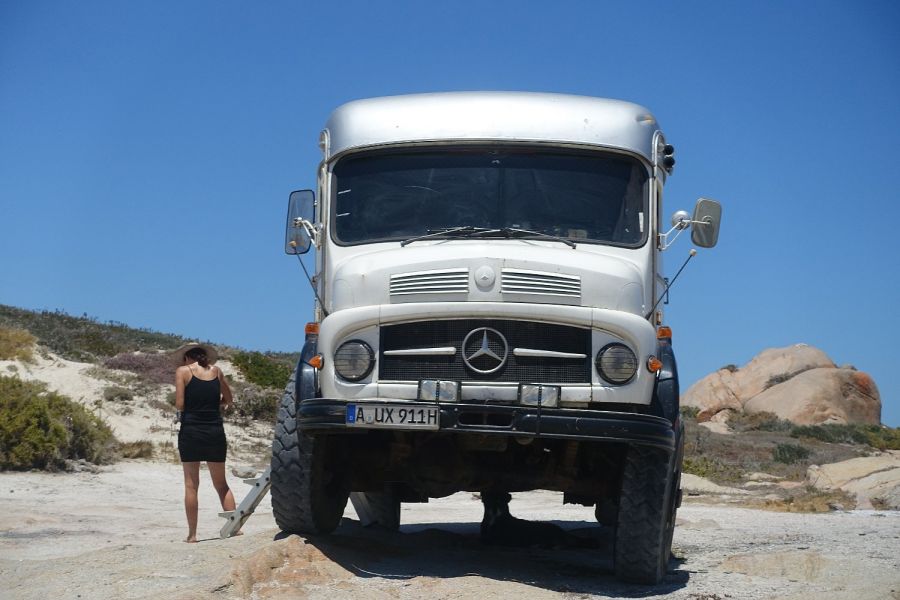
Südafrika – Westcape

Ciao Kapstadt
Jetzt wurde es dann doch mal Zeit, los zu lassen, dachten wir uns, aber Kapstadt hat es uns schon echt angetan. Es gibt ja wirklich tolle Städte, wie z.B. Auckland, Barcelona, oder Istanbul, aber Cape Town toppt das irgendwie alles, was vor allem an der „Top“ographie liegen dürfte, aber auch an der Herzlichkeit der Menschen. Mehrfach sind wir auf den Lionshead geklettert, um uns die Szene in Ruhe von oben anzusehen. Toll, wenn die Wolken wie im Zeitraffer an einem vorbei fetzen und der Blick endlos über das Häusermeer der Plains und auch das echte reicht. Auch ein Grund, warum es sich hier auch so gut aushalten lässt, sind für uns natürlich die ganz vorzüglichen Fresstempel. 
Bürokratisches – Carnet de Passages und Substitution
Eigentlich hätten wir ja am 31. Januar aus der Zollunion ausreisen müssen, also das Land Richtung Mozambique, oder Simbabwe verlassen, da unser Zolldokument für’s Auto (Carnet) nur ein Jahr Gültigkeit hat und das Anschlußcarnet pünktlich aktiviert werden muss. Das wären dann mal schnell 2000 km einfach gewesen. Aber nach ein wenig Recherche beim Zoll und Automobilclub, haben wir herausgefunden, daß man über den AASA (Südafrikanischer Automobilclub) einen Antrag bei der SARS (Zollbehörde) in Jo-Burg stellen kann. Das ließ sich dann alles einfachst per Email abwickeln. Mit der Genehmigung (Substitution) in der Tasche, hat uns dann der Zoll in Kapstadt das alte Carnet ausgestempelt und das neue eingetragen. Super.
Westcoast und Cederberg
Fährt man von Kapstadt an der Küste nach Norden, wird es dann auch gleich dünn mit der Besiedelung. Der Atlantik brandet wild an kilometerlange weisse Strände und hier und da klebt ein Dörfchen am Ufer. Dies sind meist Urlaubshäuschen der Städter und so mancher Ort besteht aus toll renovierten Fischerhäuschen, wie z.B. Paternoster. Ein tolles Küstencamp gibt es dort auch. Weiter oben bei Lambertsbay waren wir im ältestem Freiluftrestaurant des Landes, direkt am Strand, sehr urig, mit grossem Buffet einheimischen Futters und riesigen Grills auf denen Flusskrebse (Crayfish) und Fisch aller Arten zubereitet wurde. Dann bogen wir Richtung Osten ab und sind in den kleinen Gebirgszug der Cederberge gekurvt. Bizarre Formationen aus verwittertem Fels, durchzogen von teils sehr fruchtbaren Tälern, in denen vorzugsweise Zitrusfrüchte angebaut werden. Hier lässt sich toll Wandern und man findet wunderschöne Campingplätze an kleinen Flüsschen mit Naturpools zum Planschen.
Die Winelands
Südlich und östlich der grossen Stadt befinden sich auch die grössten Weinanbaugebiete des Landes und so buhlen zahlreiche Weingüter mit angeschlossenen Lodges und Restaurants um die Gunst des geneigten Kunden. Hier würden wir auch gerne noch ein paar Wochen Feldforschung betreiben, aber: Weiter geht’s Richtung Gardenroute.
C.U. Capetown
It had been time to let go, but this town catched us really. There are beautiful cities in this world, like for example Auckland, Barcelona, or Istanbul, but Cape Town is top, maybe because of its „top“ographics and sure because of the sunny-hearted people. More than once, we climbed the Lionshead, to have scenic a look on it all. Great, when the clouds rush by, like in a time-lapse movie and the view reaches endless amongst the sea and the vaste Cape Plains housings. Another reason for us to stay here are for sure the excellent dinings. From best Sushi, over Pizza like it should be, up to indian fine-dining.
Our favorite: Chef’s Warehouse, a well done mixture between a rustic tappas restaurant and a delicatessen with also sale of high-level kitchen equipment and cookbooks. No reservations, easy-going and mega yummy. This city really is a good place to hide the winter. (And the number of german clima-refugees is, as mentioned before, accordingly high.)
Burocracy – Carnet de Passages and Substitution
Due to the expiry of our carnet, we had to leave the South-African customs union in direction Mozambique, or Zimbabwe to activate the follow-up carnet. That would have been 2000 km single-way. But after a bit of research, we found out, that the AASA (Automobile Club) can arrange a substitution with the SARS (Customs), which could be managed via email easily. With this document in the pocket, the customs in Cape Town stamped out the old carnet and activated the new one. Great.
Westcoast and Cederberg
If you leave Cape Town northward, there is not much of a population. The Atlantic Ocean roars wildly amongst the vast white beaches and here and there small villages are sticking on the coastline. Mostly vacancy homes for the city-people, some of them well restaurated fishermen cottages, like in the beautiful place Paternoster. There is also a great coastal-campsite. Up north in Lambertsbay, we’ve been to Z.A.s eldest open-air-restaurant, a quaint place, right on the beach with a big buffet of local food and huge grills, where crayfish and lots of other fish are roasted. After this, we took the road to east and went into the Cedar Berg mountain range. Rocks bizarre, with valleys full of citrus crops. A great place to hike with wonderful Campsites, settled at riverbeds with natural pools to splash in.
The Winelands
South and east of the big city, you can find the region, where most of the great south-african wine is grown. And a lot of wineries woo for the customers with their lodges and restaurants. Also an area, where we would like to spend some weeks for research…
But: Off we go, in direction Gardenroute.













